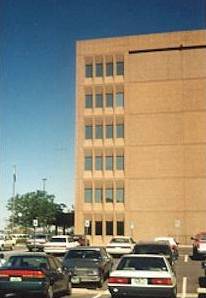
In 1974 students of Thornton High School researched and studied history in the Adams County area. One of their most interesting efforts was Fort Convenience. The students were handed a list of Adams County historical mysteries and some of them picked "Fort Vasquez No. I." History books show that there was only one Fort Vasquez and it was not in Adams County. So the class traveled to Fort Vasquez museum in Platteville. They could find nothing about Fort Convenience, but were told that Louis Vasquez had built many forts in the area. As they looked through the museum one of the students discovered a plaque that was attached to a painting of Louis Vasquez that said that he had also built Fort Convenience, five miles north of Denver.
Further research showed that in 1832 Louis Vasquez built Fort Convenience where the Adams County Social Services Building in Commerce City is now located. 
Colorado history shows that in 1819 Army Major Stephen Long led an expedition to the Great American Dessert, as Zebulon Pike called this area. Long traveled in a 75 foot boat shaped like a dragon, to scare the Indians, but the Missouri River was too shallow and an outbreak of scurvy killed many of the men. The expedition ended in Council Bluffs, Iowa. The Army sent Major Long and 19 men back in June of 1819 to search for the mouth of the Platte River.
On July 5 the party camped in a cottonwood grove opposite a river they called "Cannonball Creek" because of round rocks that looked like cannonballs. Today the River is named Clear Creek.
Even in his early twenties Louis Vasquez was known as an "old mountain man." Vasquez was not an average mountainman, for he was well educated and spoke eight languages. Historian LeRoy R. Hafen located Fort Convenience at the mouth of Clear Creek.
Fort Convenience was the first of a number of "forts" that were built on the South Platte River. Because no one knew whether this area was part of America, Mexico or Indian country it was assumed that whoever got to the area first was the owner. So it was to the advantage of America to have almost any structure built on the frontier called a "fort." It also added safety and helped to convince reluctant trappers to work with the fur company.
Perhaps Fort Convenience was just a rest stop with a big name. It was probably built out of cottonwood logs and adobe bricks and was a center for fur trade, and a trading post where mountainmen could buy flour, salt and gunpowder. The small store was stocked with beads, mirrors, and bells that men could use to flirt with the Indian women.
The Indians did not come to the fort. Vasquez and his men went to the Indians to trade but mountainmen led lonely lives and Vasquez gave big parties that lasted for days and featured jugglers, wrestling, music, gambling and shooting matches. The Indians who lived nearby came to dance and sing for the men they did business with.
Vasquez planned to use the river to transport furs to market but it was not deep enough and so Fort Convenience began to die. It was closed around 1836. In the fall of 1835 Louis Vasquez and Andrew Sublette built another Fort Vasquez, located near present-day Platteville.  Vasquez also built Fort Sarpy, Fort Lancaster and Fort St. Vrain. Fort Vasquez was besieged by Indians in 1842 and later burned and abandoned.
Vasquez also built Fort Sarpy, Fort Lancaster and Fort St. Vrain. Fort Vasquez was besieged by Indians in 1842 and later burned and abandoned.
(Information for this article was obtained from "Adams County, Crossroads of the West," and "The Forgotten Past of Adams County" published by students of Thornton High School.)

